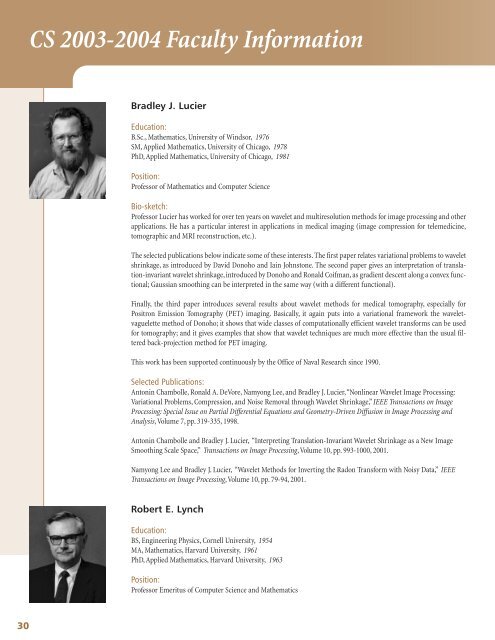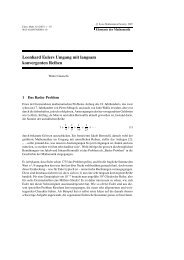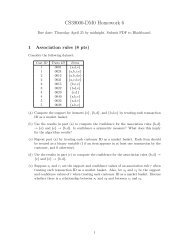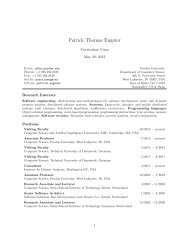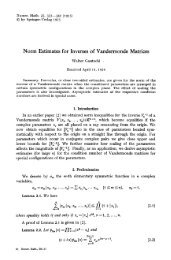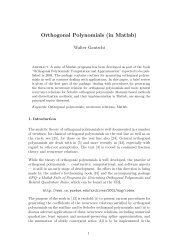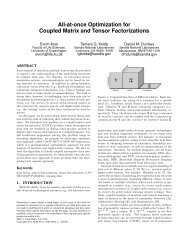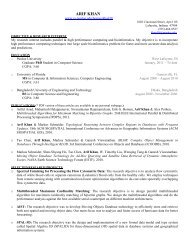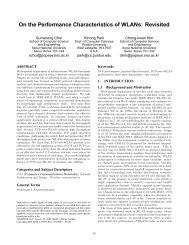CS 2003-2004 Faculty Information - Department of Computer ...
CS 2003-2004 Faculty Information - Department of Computer ...
CS 2003-2004 Faculty Information - Department of Computer ...
Create successful ePaper yourself
Turn your PDF publications into a flip-book with our unique Google optimized e-Paper software.
30<br />
<strong>CS</strong> <strong>2003</strong>-<strong>2004</strong> <strong>Faculty</strong> <strong>Information</strong><br />
Bradley J. Lucier<br />
Education:<br />
B.Sc., Mathematics, University <strong>of</strong> Windsor, 1976<br />
SM, Applied Mathematics, University <strong>of</strong> Chicago, 1978<br />
PhD, Applied Mathematics, University <strong>of</strong> Chicago, 1981<br />
Position:<br />
Pr<strong>of</strong>essor <strong>of</strong> Mathematics and <strong>Computer</strong> Science<br />
Bio-sketch:<br />
Pr<strong>of</strong>essor Lucier has worked for over ten years on wavelet and multiresolution methods for image processing and other<br />
applications. He has a particular interest in applications in medical imaging (image compression for telemedicine,<br />
tomographic and MRI reconstruction, etc.).<br />
The selected publications below indicate some <strong>of</strong> these interests. The first paper relates variational problems to wavelet<br />
shrinkage, as introduced by David Donoho and Iain Johnstone. The second paper gives an interpretation <strong>of</strong> translation-invariant<br />
wavelet shrinkage, introduced by Donoho and Ronald Coifman, as gradient descent along a convex functional;<br />
Gaussian smoothing can be interpreted in the same way (with a different functional).<br />
Finally, the third paper introduces several results about wavelet methods for medical tomography, especially for<br />
Positron Emission Tomography (PET) imaging. Basically, it again puts into a variational framework the waveletvaguelette<br />
method <strong>of</strong> Donoho; it shows that wide classes <strong>of</strong> computationally efficient wavelet transforms can be used<br />
for tomography; and it gives examples that show that wavelet techniques are much more effective than the usual filtered<br />
back-projection method for PET imaging.<br />
This work has been supported continuously by the Office <strong>of</strong> Naval Research since 1990.<br />
Selected Publications:<br />
Antonin Chambolle, Ronald A. DeVore, Namyong Lee, and Bradley J. Lucier,“Nonlinear Wavelet Image Processing:<br />
Variational Problems, Compression, and Noise Removal through Wavelet Shrinkage,” IEEE Transactions on Image<br />
Processing: Special Issue on Partial Differential Equations and Geometry-Driven Diffusion in Image Processing and<br />
Analysis, Volume 7, pp. 319-335, 1998.<br />
Antonin Chambolle and Bradley J. Lucier, “Interpreting Translation-Invariant Wavelet Shrinkage as a New Image<br />
Smoothing Scale Space,” Transactions on Image Processing, Volume 10, pp. 993-1000, 2001.<br />
Namyong Lee and Bradley J. Lucier, “Wavelet Methods for Inverting the Radon Transform with Noisy Data,” IEEE<br />
Transactions on Image Processing, Volume 10, pp. 79-94, 2001.<br />
Robert E. Lynch<br />
Education:<br />
BS, Engineering Physics, Cornell University, 1954<br />
MA, Mathematics, Harvard University, 1961<br />
PhD, Applied Mathematics, Harvard University, 1963<br />
Position:<br />
Pr<strong>of</strong>essor Emeritus <strong>of</strong> <strong>Computer</strong> Science and Mathematics


